Understanding Food Selectivity in Autism Spectrum Disorder
Food selectivity is a prevalent challenge among children with Autism Spectrum Disorder (ASD), affecting approximately 46% to 89% of this population. It manifests as a limited diet characterized by refusal to try new foods, preference for specific textures, and ritualistic eating behaviors. Such restrictions can lead to nutritional deficiencies, health issues, and social isolation during mealtime. Addressing these challenges requires tailored interventions that are both effective and minimally intrusive, with Applied Behavior Analysis (ABA) standing out as a scientifically supported approach.
Defining Food Selectivity in Autism Spectrum Disorder
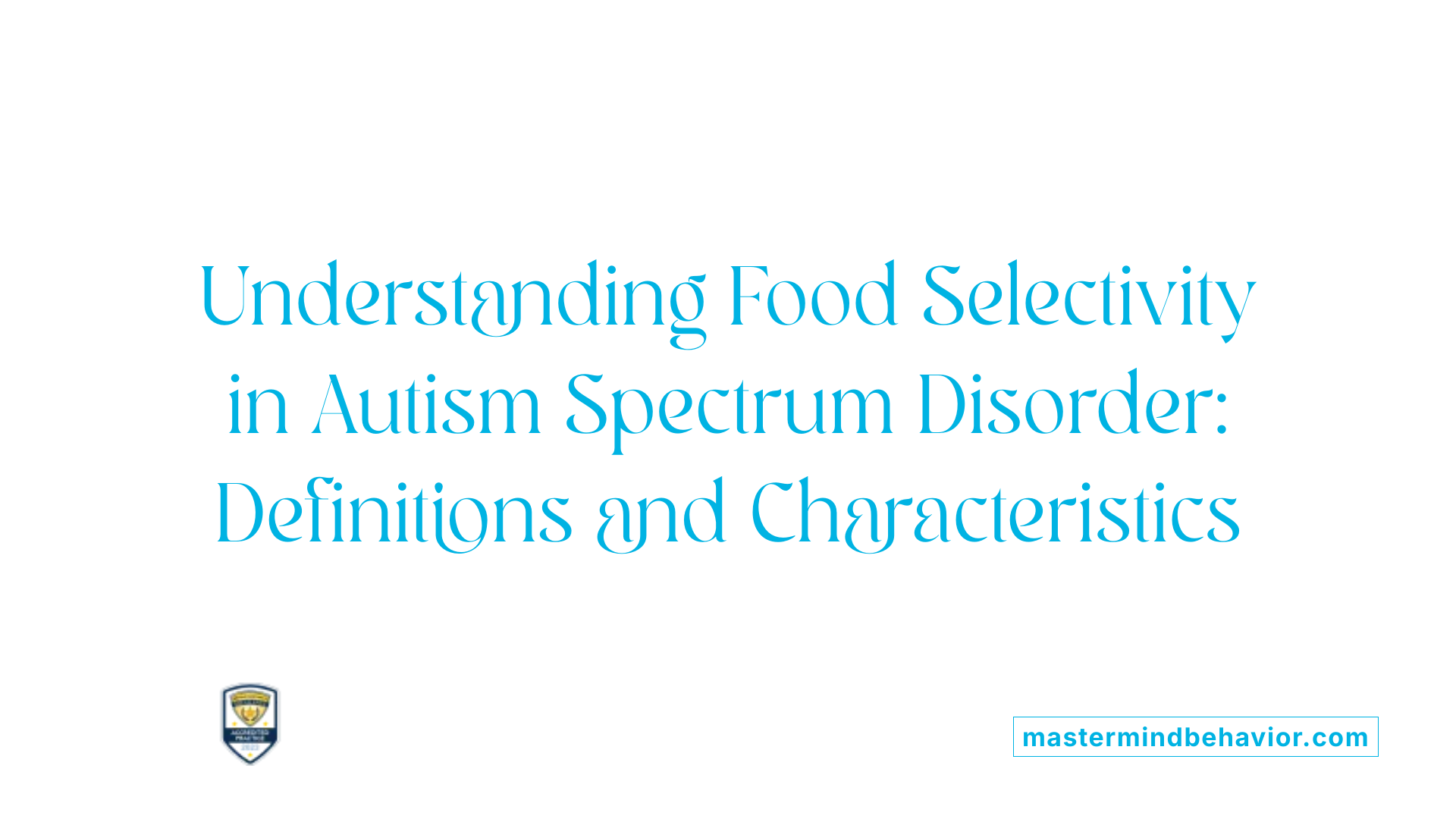
What is food selectivity in autism and how is it characterized?
Food selectivity in children with autism spectrum disorder (ASD) is a common challenge, affecting often between 46% to as high as 89% of children on the spectrum. It is primarily characterized by a restricted diet that includes a narrow range of acceptable foods, often limited to fewer than 8-20 items. These children tend to display strong rigidity in their food choices and may have an intense preoccupation with specific foods.
This behavior is influenced by sensory sensitivities related to textures, odors, and visual stimuli, which lead many children with ASD to reject foods that are unfamiliar or different from their usual diet. They often prefer routine, and this preference for sameness results in limited dietary diversity.
The behaviors associated with food selectivity can include refusing to try new foods, spitting out or pushing away foods they dislike, or only accepting certain textures and flavors. Such behaviors may create significant challenges during mealtimes, affecting the social aspects of eating and increasing meal-related distress.
Nutritionally, this restrictive eating pattern can lead to deficiencies in vital nutrients such as proteins, vitamins, and minerals, increasing the risk of health problems such as malnutrition, weight loss, or failure to thrive.
Managing this issue involves implementing structured meal routines and gradual exposure to new foods, often combined with behavioral strategies such as positive reinforcement, stimulus fading, and taste exposure. Professional guidance from dietitians and behavioral therapists is crucial to ensure that children receive balanced nutrition and to reduce mealtime behavioral difficulties.
Characteristics of food selectivity in children with ASD
- Limited food repertoire (usually fewer than 20 foods)
- Preference for routine and sameness
- Strong sensory sensitivities affecting acceptance
- Behavioral resistance to new or unfamiliar foods
- Ritualistic and repetitive mealtime behaviors
- Potential health risks due to poor diet variety
Behavioral and sensory aspects
Children with ASD often demonstrate sensory processing anomalies impacting their eating behaviors. Textures, smells, and visual presentation of foods can trigger aversive reactions, leading to food refusal. Behavioral interventions focus on gradually increasing acceptance through procedures like stimulus fading, taste exposure, and reinforcement.
Health implications of restricted diets
The consequences of food selectivity include the risk of nutritional deficiencies, such as lack of essential vitamins and minerals, which can impair growth and development. Severe restrictions may result in medical issues like anemia, rickets, or gastrointestinal disturbances. Additionally, emotional and social challenges at mealtime may affect family dynamics and the child's overall quality of life.
| Aspect | Description | Impact |
|---|---|---|
| Typical food repertoire | Usually fewer than 20 preferred foods | Nutritional gaps, risk of deficiencies |
| Behavioral characteristics | Rituals, refusal, insistence on routines | Mealtime stress, social withdrawal |
| Sensory sensitivities | Texture, smell, appearance may cause aversion | Food refusal, limited variety |
| Health risks | Nutritional deficiencies, growth delays | Malnutrition, vitamin deficiencies, poor health |
| Intervention strategies | Gradual exposure, reinforcement, stimulus fading, structured routines | Increased food variety, reduced refusals |
Understanding the multifaceted nature of food selectivity in ASD is essential for designing effective interventions. Tailoring approaches to each child's sensory profile and behavioral patterns can significantly improve eating behaviors and nutritional intake.
Behavioral Principles of ABA in Managing Food Selectivity
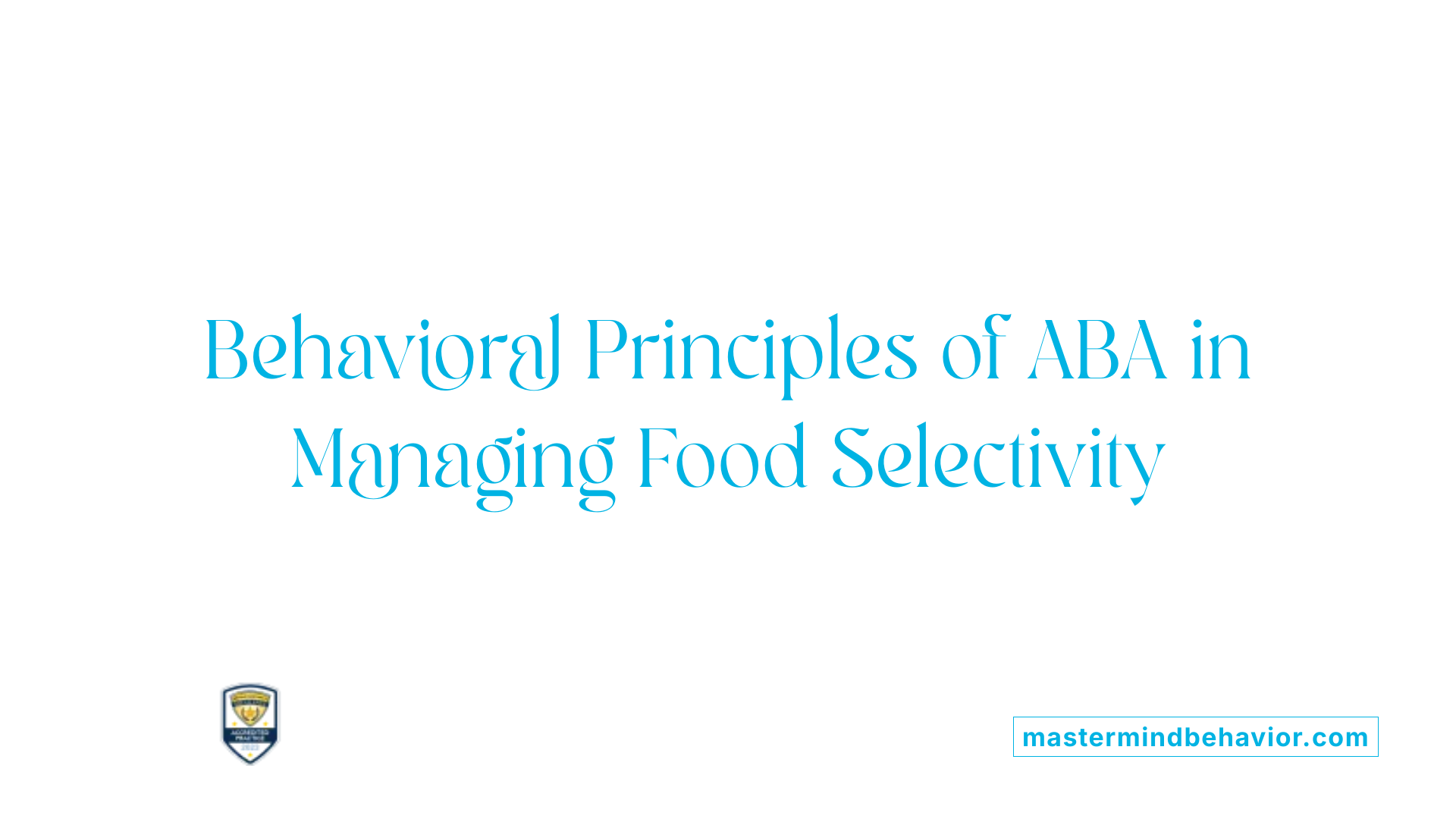
What are the principles of ABA therapy in managing food selectivity?
Applied Behavior Analysis (ABA) provides a structured and evidence-based approach to addressing food selectivity in children with Autism Spectrum Disorder (ASD). The foundational principles involve thorough assessment processes, such as preference assessments and functional analyses, to understand what reinforces or maintains refusal behaviors. These assessments help tailor interventions specifically to each child's needs.
Interventions predominantly employ reinforcement strategies, including differential reinforcement—a technique that reinforces desirable behaviors (like trying a new food) while withholding reinforcement for refusal behaviors. Shaping involves reinforcing successive approximations towards the target behavior, such as touching, licking, and then eating a new food. Stimulus fading gradually increases the variety and presentation of nonpreferred foods, making them more acceptable over time.
Importantly, ABA therapy emphasizes ethical practices that respect child autonomy. Avoiding restrictive procedures like escape extinction—where food or utensils are not removed to prevent avoidance—ensures treatment remains respectful and considers the child's well-being. When used, escape extinction must be carefully monitored to manage challenging behaviors like gagging or screaming.
Interventions are highly individualized, integrating multiple strategies such as preference assessments, fading, and reinforcement to promote functional eating behaviors. Parent training is also crucial, as coaching on techniques like modeling and providing choices facilitates consistent implementation across settings.
In summary, ABA therapy employs a combination of assessment-driven, reinforcement-based, and fading techniques within a framework that upholds ethical standards and prioritizes child choices to effectively manage food selectivity.
Assessment Strategies for Food Selectivity
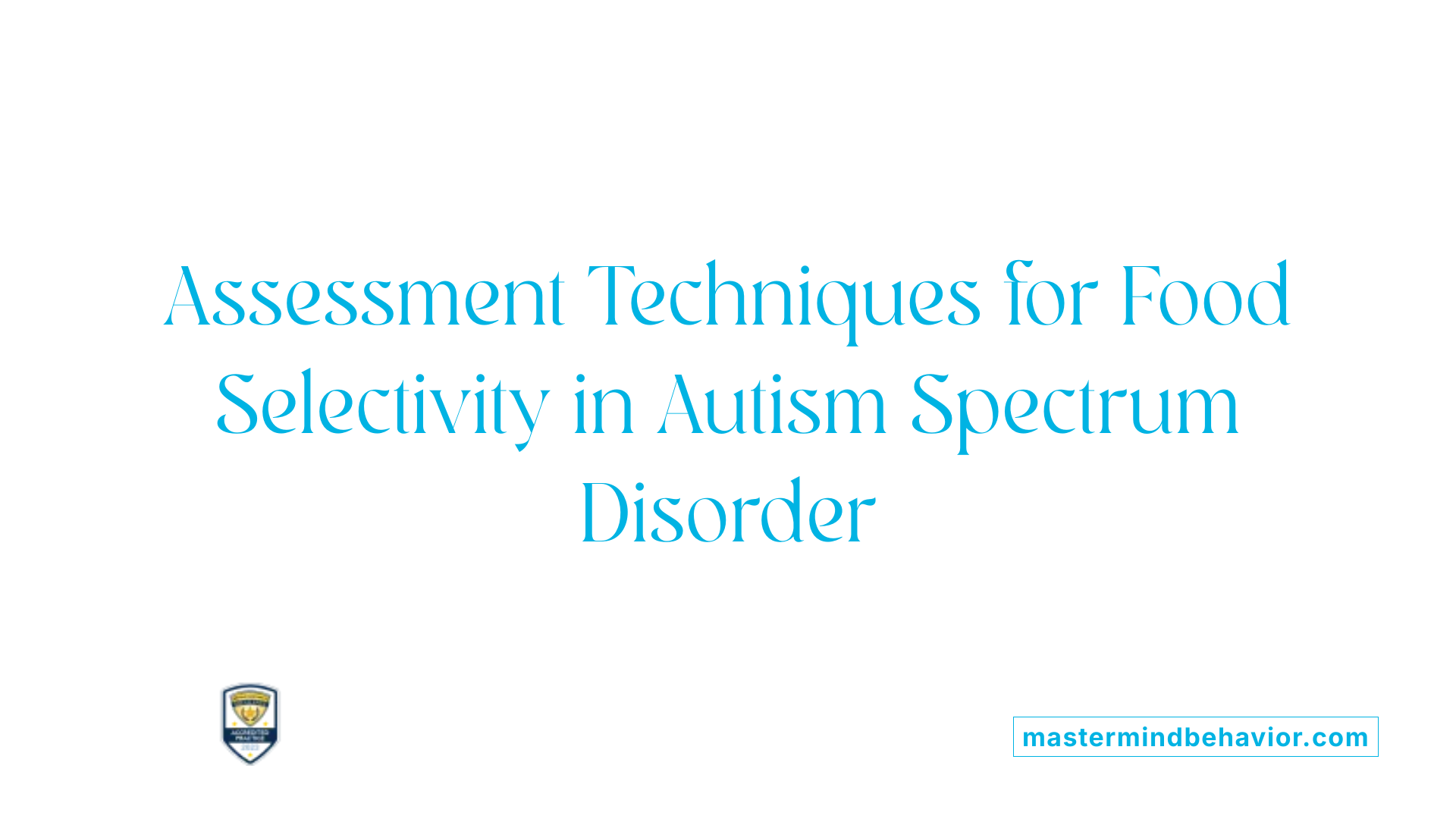
What are common assessment methods for food selectivity in children with autism in the context of ABA therapy?
Assessing food selectivity in children with autism is a crucial step in developing effective intervention plans. Both indirect and direct assessment methods are employed to gather comprehensive information about the child's eating behaviors and preferences.
Indirect assessment methods involve talking with caregivers and collecting background information. This includes conducting interviews, preference surveys, and questionnaires that explore the child's typical eating patterns, food likes and dislikes, and specific problematic mealtime behaviors. These tools help clinicians understand the child's food environment and identify possible triggers for food refusal.
Direct assessment methods provide empirical data by observing the child's interactions with different foods through structured sessions. Preference assessments such as single-stimulus tests, where one food item is presented at a time, and paired choice assessments, which involve presenting two foods concurrently, are commonly used. During these assessments, clinicians record which foods the child chooses and how much they consume, alongside any problem behaviors like spitting or pushing food away.
Functional analyses, including the interview-informed synthesized contingency analysis (IISCA), help identify the underlying environmental factors maintaining food refusal. These analyses manipulate various antecedents and consequences to observe their effects on the child's behavior, allowing for tailored interventions.
The combination of these assessment methods provides a detailed picture of the child's food preferences, potential sensory sensitivities, and functional reasons for food refusal. This comprehensive evaluation ensures that intervention strategies are specifically targeted to address individual needs.
| Method Type | Examples | Purpose | Additional Details |
|---|---|---|---|
| Indirect | Caregiver interviews, preference surveys, questionnaires | To gather background info on eating habits, preferences, and behaviors | Helps identify areas for targeted assessment |
| Direct | Preference assessments (single-stimulus, paired-choice) | To empirically determine preferred and non-preferred foods | Facilitates understanding of actual food preferences |
| Functional analysis | IISCA, environmental manipulations | To identify environmental contingencies maintaining refusal | Enables development of function-based interventions |
Understanding and applying these assessment techniques allow practitioners to design effective, individualized ABA-based interventions aimed at reducing food selectivity and expanding dietary variety in children with ASD.
Implementing ABA Interventions in Food Selectivity Treatment
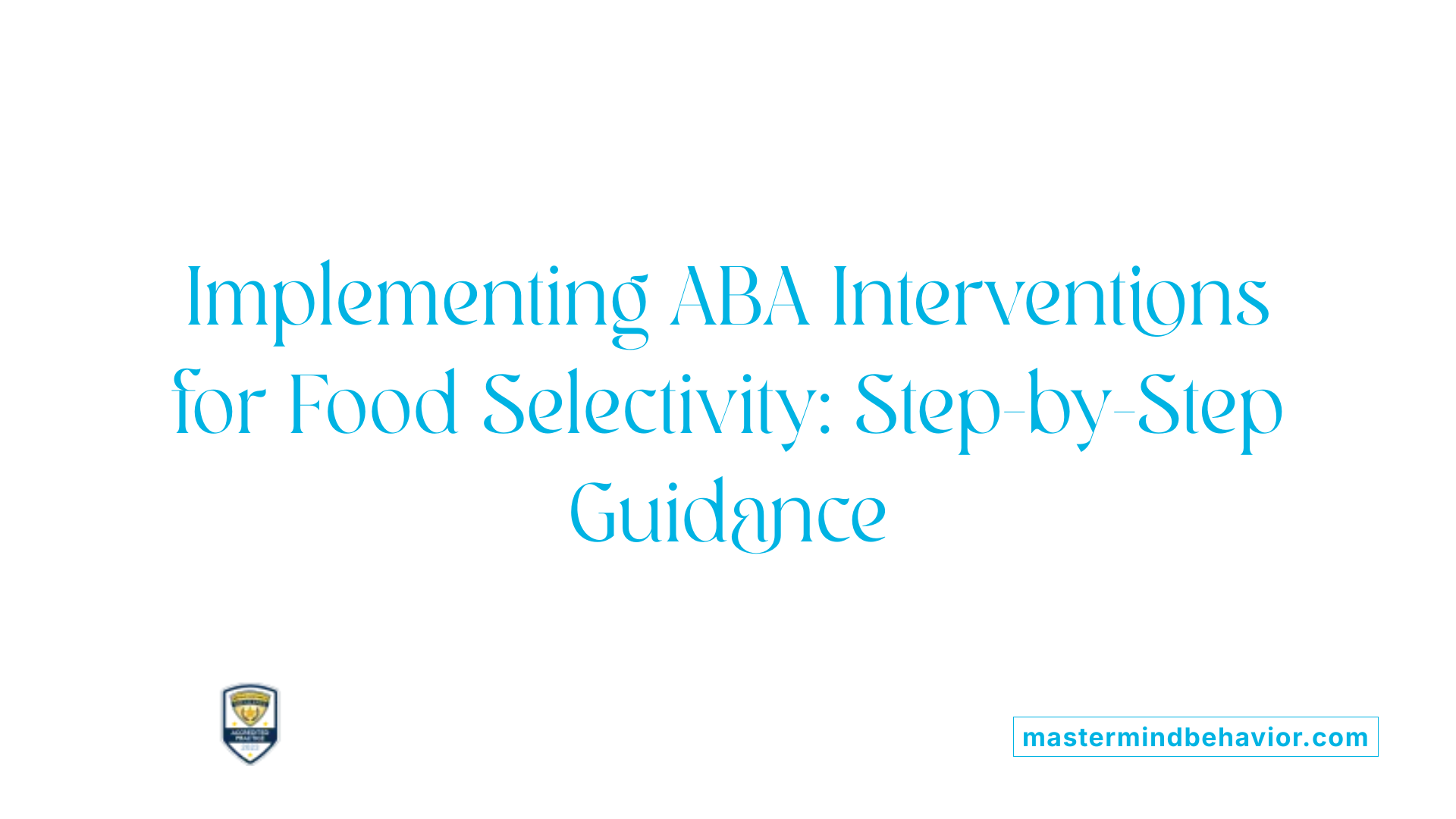
How is ABA therapy used to address food selectivity in children with autism?
Applied Behavior Analysis (ABA) therapy offers a structured, evidence-based approach to tackling food selectivity among children with autism spectrum disorder (ASD). It employs core principles such as reinforcement, prompting, shaping, and fading to gradually increase a child’s acceptance of various foods.
Therapists might start by conducting preference assessments to identify highly preferred foods, which serve as effective reinforcers during interventions. These assessments help tailor strategies that motivate the child to try new foods. Behavioral techniques like stimulus fading involve gradually transitioning from favored foods to less preferred ones by slowly modifying visual features, textures, or presentation methods.
In practical terms, interventions target specific behaviors, including refusing foods, spitting, gagging, or resistance during mealtimes. Through repeated taste exposure and structured routines, children learn to tolerate and accept a wider variety of foods. Reinforcement plays a vital role; for example, offering praise, preferred items, or activities immediately following successful tasting or eating helps strengthen positive behaviors.
Parent training is a significant component of effective treatment. Families are coached to implement these strategies at home, ensuring consistency across environments. This training includes techniques like role-playing, video modeling, and coaching to help caregivers apply reinforcement, manage disruptive behaviors, and gradually fade prompts.
Environmental modifications are also crucial. Changing the mealtime setting to reduce distractions, establishing predictable routines, and utilizing visual supports such as picture schedules enhance the child's comfort and independence during eating.
Organizations specializing in ASD, like Empower Behavioral Health, develop individualized ABA feeding programs based on comprehensive assessments. These plans include direct observations, sensory profiles, and data collection to monitor progress and adjust strategies accordingly.
Overall, ABA therapy's systematic, individualized approach helps children with ASD overcome food selectivity, leading to increased dietary variety, improved nutritional intake, and more positive mealtime experiences.
Strategies and Techniques Employed in ABA to Improve Food Acceptance
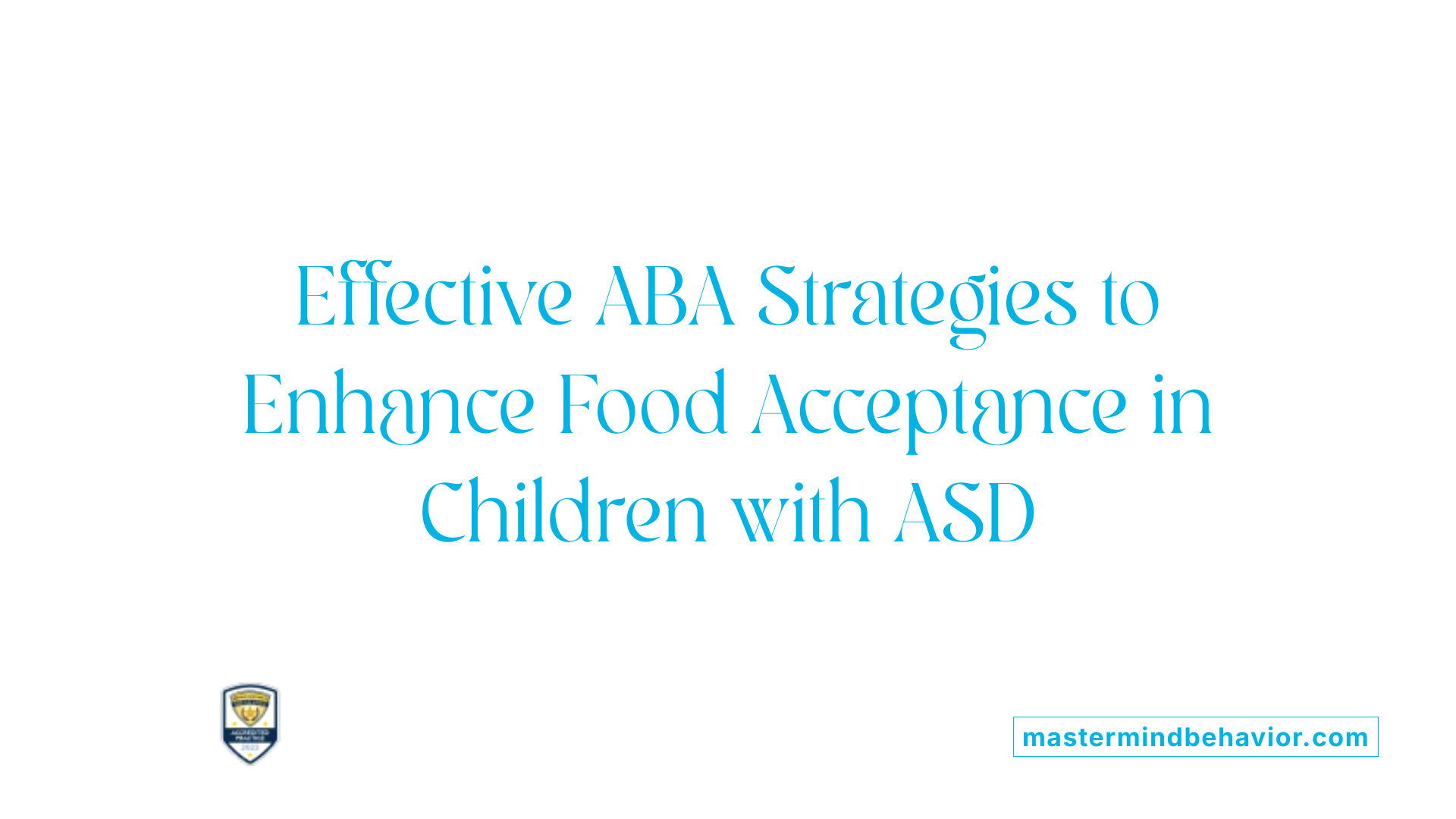
What treatment strategies does ABA therapy utilize to improve food selectivity in children with autism?
ABA therapy incorporates a variety of behavioral strategies carefully tailored to address food selectivity in children with ASD. Central to these approaches are reinforcement procedures, stimulus fading, shaping, and structured routines that work together to expand a child's dietary variety.
Reinforcement is one of the foundational techniques used in ABA interventions. Positive reinforcement involves providing preferred items or activities contingent on attempts to try or accept new foods. This increases the likelihood that children will continue to explore and accept different foods over time. For example, a child might earn access to a favorite toy or activity after trying a new vegetable or a less preferred texture.
Stimulus fading is another effective method, which gradually modifies the presentation of foods to make acceptance easier. For instance, beginning with pureed or highly textured foods similar to those the child already eats, and slowly increasing texture complexity or exposure to different sensory features such as smell and appearance. This gradual process helps desensitize sensory sensitivities, which are common in children with ASD.
Shaping involves reinforcing successive approximations toward the desired behavior—such as touching the food to the lips, licking, then eating. This stepwise approach builds confidence and acceptance gradually, reducing refusal behaviors.
Another critical component is the development of structured meal routines and chaining techniques. Consistent routines reduce anxiety by establishing predictable meal and snack times, thereby encouraging participation. Chaining, or breaking down a multi-step feeding behavior into smaller, manageable steps, helps children learn to complete each part of the mealtime process more independently.
Speficically, techniques like taste exposure and non-taste methods also play vital roles. Repeated taste exposure involves offering small tastes of foods multiple times to increase familiarity and acceptability. When paired with behavioral strategies such as reinforcement, this method enhances food acceptance.
Non-taste techniques include visual supports, picture schedules, and pairing food presentation with preferred activities, all designed to prepare children cognitively and emotionally for new foods and mealtime routines.
Incorporating these strategies into treatment plans has shown significant success across numerous studies and clinical cases, leading to increased food variety, reduced food refusal, and improved mealtime behaviors. This comprehensive, individualized approach is often implemented by trained professionals but can also be taught to parents for consistency at home.
Summary table of ABA strategies for improving food acceptance:
| Strategy | Description | Example |
|---|---|---|
| Reinforcement | Providing preferred stimuli contingent on food acceptance | Earning a favorite toy after trying a new vegetable |
| Stimulus Fading | Gradually increasing the sensory complexity of foods | Starting with purees, then moving to diced textures |
| Shaping | Reinforcing successive steps toward eating new foods | Touching, licking, then biting |
| Structured Routines | Establishing predictable mealtime schedules | Consistent meal times daily |
| Chaining | Breaking down feeding behaviors into steps | Sitting at table, reaching for food, biting |
| Taste Exposure | Repeatedly offering small tastes of foods | Offering a spoonful of new food multiple times |
| Visual Supports | Using pictures or charts to guide behaviors | Picture schedule of meal steps |
By integrating these evidence-based techniques, ABA therapy effectively targets food selectivity, supporting healthier and more varied diets for children with ASD.
Effectiveness of ABA Therapy in Addressing Food Selectivity
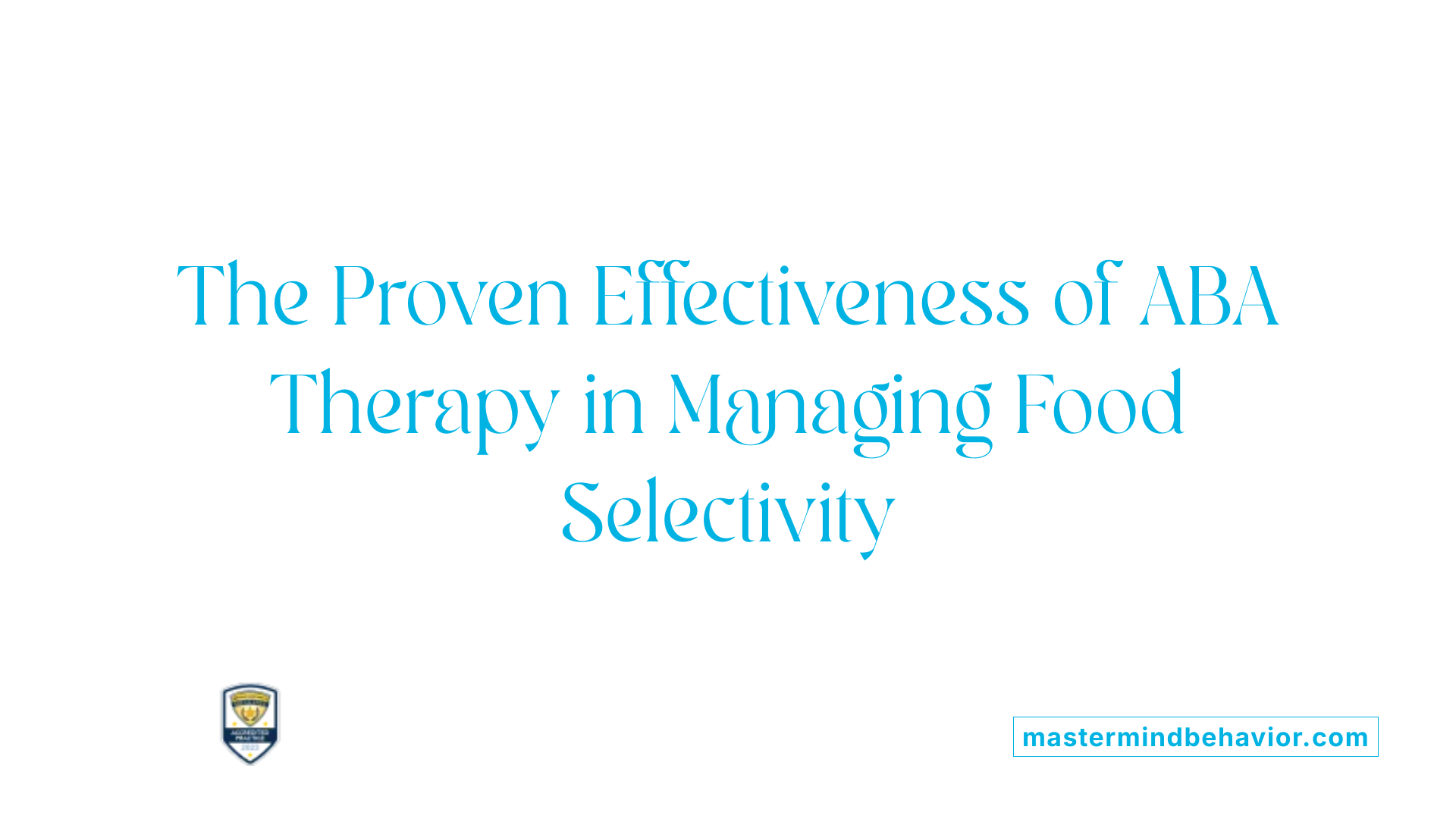
How effective is ABA therapy in addressing food selectivity issues in children with autism?
Applied Behavior Analysis (ABA) therapy has been extensively researched and shown to be highly effective in reducing food selectivity among children with autism spectrum disorder (ASD). Multiple studies indicate that ABA techniques such as reinforcement, extinction, differential reinforcement, and escape prevention are capable of significantly increasing children's acceptance of a broader variety of foods.
Research findings reveal that these interventions not only improve the willingness to try new and non-preferred foods but also enhance related feeding skills like chewing and swallowing. Importantly, implementing ABA strategies has consistently led to notable decreases in problematic mealtime behaviors, such as food refusal, spitting, gagging, and distress signals.
Case studies support these findings. For example, a 9-year-old girl with ASD who exhibited severe food selectivity—eating only liquids and semi-solids—showed substantial improvement after a multicomponent ABA-based intervention, which included texture fading, stimulus fading, and positive reinforcement. Data collection across multiple foods illustrated positive trends in acceptance and reductions in problematic behaviors.
In school settings, sensory-based feeding interventions rooted in ABA principles have expanded food variety and reduced distress, demonstrating that these approaches can be seamlessly integrated into daily routines. The success of such interventions largely depends on proper individualization and consistent implementation.
Furthermore, clinical and research evidence highlights that starting with foods similar to the child's current preferences and gradually increasing complexity through systematic fading techniques creates a foundational pathway toward diversified diets. Incorporating taste exposures, stimulus fading, and reinforcement facilitates meaningful progress.
While outcomes vary based on individual characteristics and precise intervention strategies, the comprehensive literature underscores ABA's position as a promising, evidence-based approach for managing food selectivity in children with ASD.
Overall, these findings affirms that with trained professionals, tailored programs, and family involvement, children with autism can experience significant improvements in food acceptance, nutritional intake, and mealtime behavior, fostering better health and quality of life.
Research Guidelines and Clinical Evidence Supporting ABA Interventions
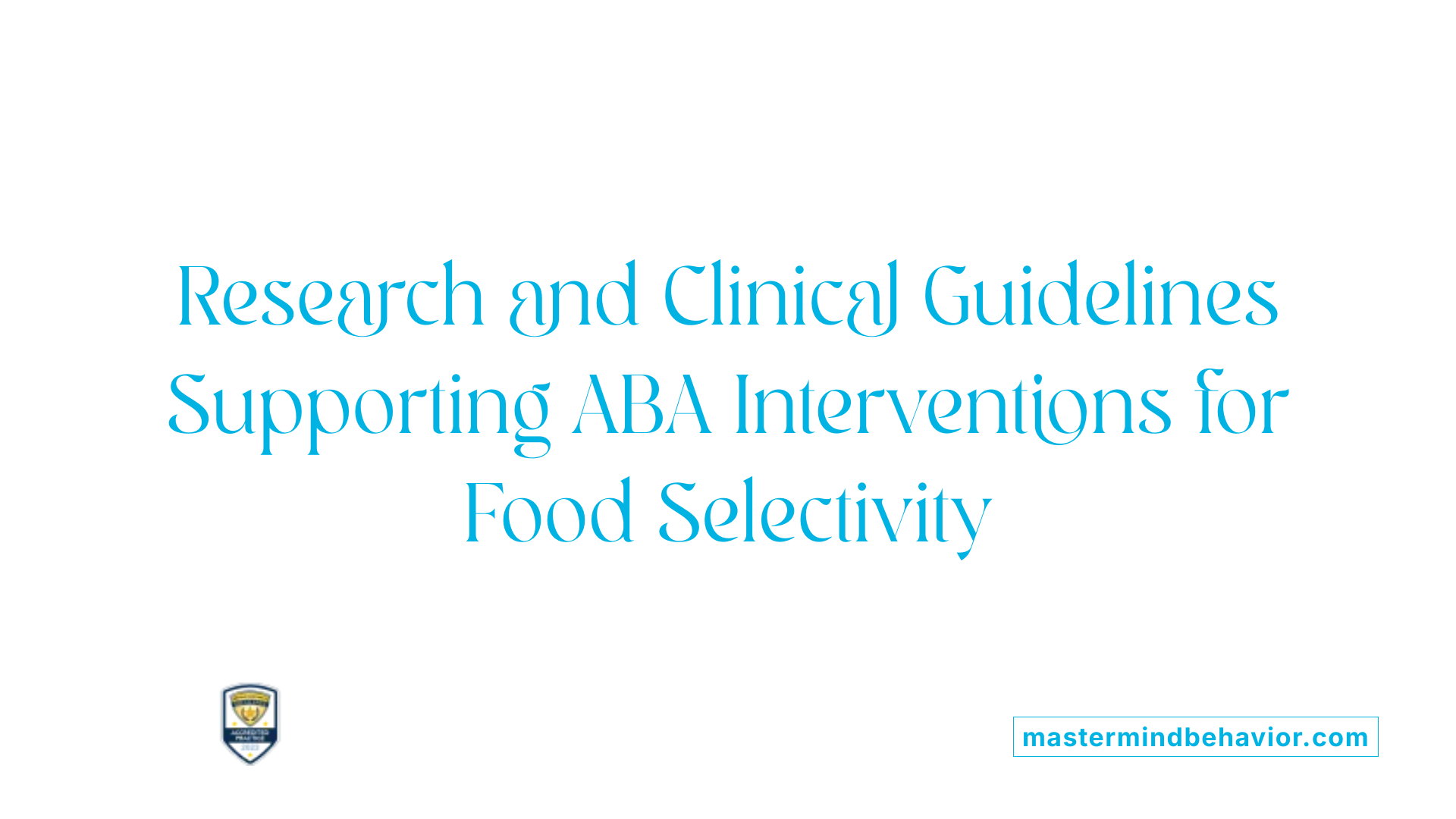
What guidelines or research support ABA interventions for food selectivity in autism?
There is substantial backing from both clinical guidelines and scientific research that advocates for the use of Applied Behavior Analysis (ABA) in addressing food selectivity among children and individuals with autism spectrum disorder (ASD). These interventions are grounded in behavioral principles that have been extensively studied and validated.
Research indicates that ABA-based interventions can effectively increase the acceptance of a broader diet, reduce food refusal behaviors, and improve mealtime routines. For example, a comprehensive review of 42 studies found that nearly all reported successful increases in food variety following ABA strategies. Most of these studies employed reinforcement and extinction procedures, with over 90% achieving positive outcomes.
Clinical guidelines recommend conducting detailed behavioral assessments to understand the specific behaviors and preferences related to food refusal. These assessments—such as preference assessments, functional analyses, and sensory profiles—help clinicians develop personalized intervention plans. These plans typically include structured routines, positive reinforcement for trying new foods, and gradual exposure techniques.
Common behavioral strategies include pairing less preferred foods with highly preferred ones, systematic desensitization involving stimulus fading, and shaping behaviors toward acceptance of new textures or flavors. Establishing a predictable mealtime routine with clear presentation of foods assists children in feeling safe and reducing anxiety.
To support dietary expansion, progressive approaches like taste exposure, sequential and simultaneous food presentation, and reinforcement of small steps are used. These methods promote gradual acceptance without overwhelming the child.
Collaboration with medical professionals is also emphasized to exclude physiological issues such as allergies or gastrointestinal problems, which can compound feeding difficulties. Integrating these guidelines ensures a holistic approach, maximizing success and ensuring nutritional adequacy.
In summary, ABA interventions for food selectivity are well-supported by research and clinical practice. They advocate for individualized, systematic, and data-driven strategies, emphasizing the importance of multidisciplinary collaboration for optimal outcomes.
Specialized Interventions in School Settings: The Sensory Snack Time Program
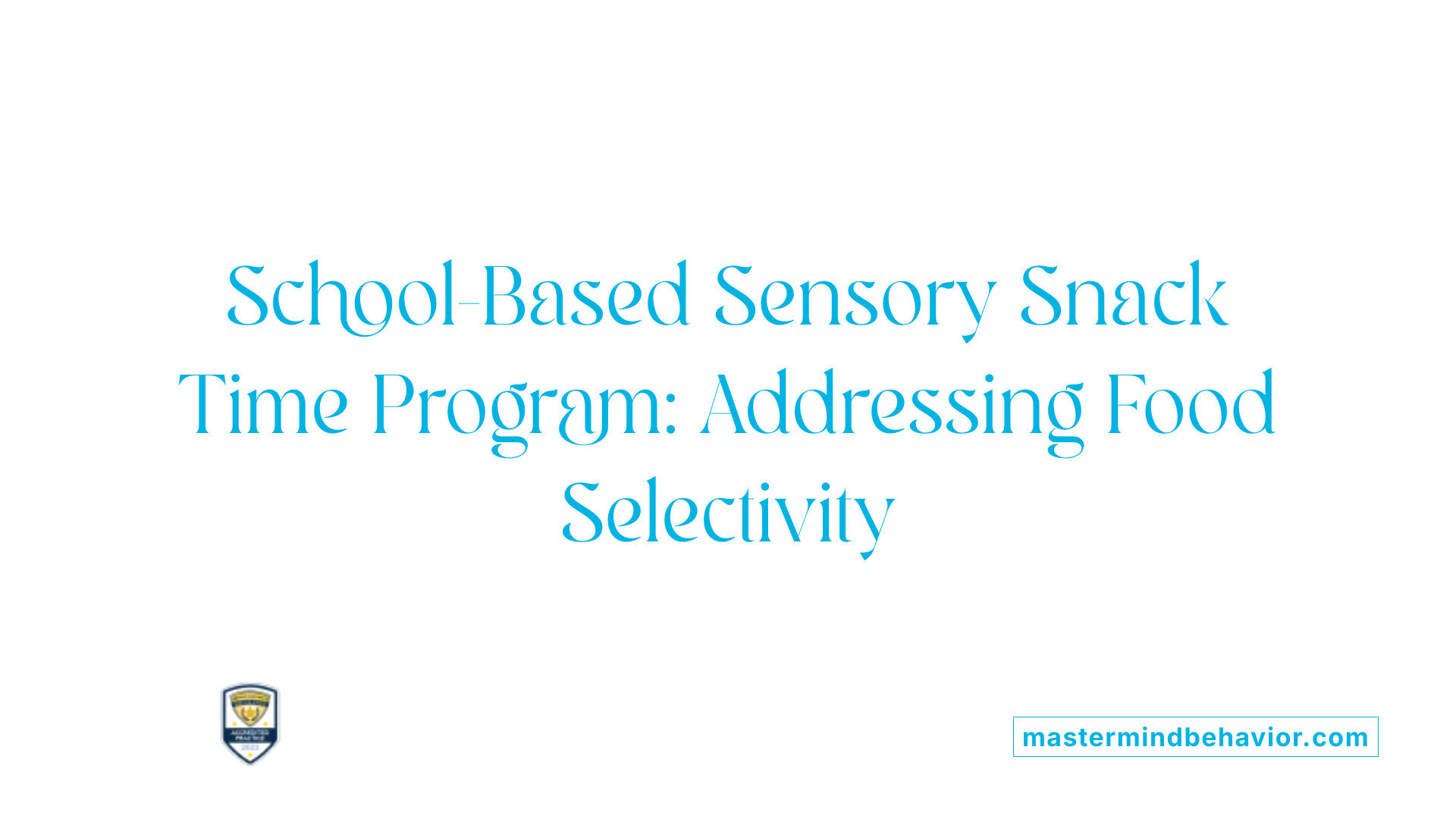
Implementation of the Sensory Snack Time Program in Schools
The Sensory Snack Time initiative exemplifies how sensory-based feeding interventions can be seamlessly integrated into school environments to effectively address food selectivity among children with Autism Spectrum Disorder (ASD). This program was designed for a special school setting, involving 23 pupils aged 4 to 10 years. It was developed to promote varied eating habits and improve mealtime behaviors through structured sensory activities.
The intervention was implemented by the existing school staff, which highlights its practicality and ease of adoption within a typical classroom setting. The program’s success largely depended on the staff’s ability to follow specific protocols that incorporate sensory exposure, behavioral reinforcement, and gradual progression in food acceptance.
Prior to beginning, a comprehensive assessment was conducted. This included detailed observations of each child's food refusal behaviors, preferences, and sensory sensitivities. This assessment informed the creation of individualized food plans and routines to ensure each child's unique needs were met.
Sensory-Based Feeding Strategies Employed
The core of the Sensory Snack Time approach revolved around sensory-based interventions. These involved gradually desensitizing children to textures, odors, and visual stimuli associated with different foods. Foods were introduced in a manner that combined both taste exposure and stimulus fading, a technique where non-preferred foods are gradually presented alongside preferred foods, and their presentation is slowly altered.
A significant element was the systematic expansion of food variety through repeated tasting and exposure. Small amounts of new or less accepted foods were offered repeatedly—often 7-10 times—to promote acceptance. This process was complemented by positive reinforcement, such as praise or preferred activities, to motivate children.
The program also employed visual supports like picture schedules and charts to enhance independence and routine predictability during meals. These visuals made it easier for children to understand mealtime sequences and reduce anxiety or rigidity.
Outcomes and Benefits
The results of the 12-week intervention were promising. Post-program, children exhibited a wider variety of foods, trying more categories such as fruits, vegetables, dairy, and proteins. Food acceptance increased markedly, with a significant reduction in food refusal behaviors.
Moreover, there was a noticeable decrease in distressed mealtime behaviors and problematic food refusal, as measured by standardized tools like the BAMBI (Behavioral Assessment of Mealtime Behavior in Children with Autism). Overall, children’s mealtime rigidity decreased, and their willingness to accept new foods improved.
This program demonstrated that sensory-based interventions could be effectively embedded within daily school routines. The ability of existing staff to deliver the intervention underscores its scalability and potential for broader application.
Broader Implications
The success of the Sensory Snack Time program underscores the value of combining behavioral strategies with sensory integration techniques. It aligns with research indicating that sensory sensitivities are strongly linked to food selectivity in children with ASD.
The approach also highlights the importance of individualized plans based on comprehensive assessments, as each child's sensory profile and preferences are unique. When these factors are addressed systematically, children are more likely to expand their diets and reduce mealtime distress, ultimately supporting better health and social engagement.
In conclusion, the integration of sensory-based feeding interventions like Sensory Snack Time into school settings offers a practical and effective way to combat food selectivity. It fosters healthier eating habits, improves mealtime behaviors, and enhances the overall well-being of children with ASD.
Novel Approaches: Multicomponent ABA-Based Interventions and Case Studies

What are multicomponent treatment packages?
Multicomponent treatment packages are comprehensive intervention strategies that combine several behavioral techniques to address food selectivity in children with autism spectrum disorder (ASD). These packages often include stimulus fading, taste exposure, positive reinforcement, shaping, and presentation methods like sequential and simultaneous food presentation. The goal is to increase acceptance of a wider variety of foods while reducing problematic mealtime behaviors.
These interventions are typically tailored based on thorough assessments, including direct observations, sensory profiles, and food preference evaluations. They are designed to be less intrusive, allowing parents, teachers, and clinicians to implement them with limited training. Such approaches emphasize consistency, patience, and gradual progression towards diverse diets.
Techniques: Texture fading, taste exposure, shaping
Texture fading involves systematically reducing the level of food texture, from pureed to chunkier, to help children gradually accept new food consistencies. For example, a child initially eats smooth purees; over sessions, small lumps are added to the food, fostering tolerance for textures.
Taste exposure is a repeated presentation of foods with similar taste profiles to those the child already accepts. This could involve offering small tastes of foods similar in flavor (e.g., different fruits or vegetables) multiple times, usually between 7-10 exposures, to encourage acceptance.
Shaping involves reinforcing incremental steps towards eating a new food. For instance, reinforcing touching the food to lips, then licking, and finally swallowing. Reinforcement can be praise, preferred items, or activities.
These methods, often combined, support gradual behavioral change and help children develop a more varied diet.
Case studies demonstrating success
A notable case involved a 9-year-old girl with ASD who exhibited severe food selectivity, eating only liquids and semi-solids. A multicomponent intervention was designed, including texture fading, stimulus fading, and positive reinforcement. The approach used an AB-type experimental design, with significant improvements observed.
After the intervention, she showed increased acceptance of semi-solid and novel foods, and her problematic mealtime behaviors decreased markedly. The structured protocol involved presenting foods in a systematic manner, gradually increasing texture variety, and reinforcing her efforts.
In another example, a class-based sensory intervention called 'Sensory Snack Time' was implemented with 23 children aged 4-10 in a school setting. The intervention lasted for 12 weeks and resulted in increased food variety, reduced distress during meals, and less food refusal.
Children tried more food categories, and problematic behaviors like food refusal and distress decreased significantly, though some rigidity remained unchanged. Remarkably, this intervention was integrated into everyday routines by the existing school staff, proving its practical applicability.
These cases highlight that multicomponent ABA strategies, when applied consistently and tailored to individual needs, can effectively improve dietary variety and mealtime behaviors in children with ASD.
Summarized Overview of Interventions
| Technique | Description | Purpose | Setting | Implementation | Expected Outcome |
|---|---|---|---|---|---|
| Texture Fading | Gradually introducing chunkier textures | Acceptance of diverse textures | Clinical or home | Systematic, incremental | Increased tolerance for various textures |
| Taste Exposure | Repeated presentation of similar foods | Acceptance of new foods | Random or structured | Repeated trials | Increased food variety |
| Shaping | Reinforcing small steps towards eating | Accepting and swallowing new foods | Clinical, home, school | Behavioral reinforcement | Expanded food repertoire |
| Presentation Methods | Sequential and simultaneous | Increase acceptance of multiple foods | Dietary routines | Consistent presentation | Greater dietary diversity |
The Role of Research and Future Directions
Emerging research indicates that integrated, sensory-based, ABA-driven interventions can significantly impact food selectivity. The success of these approaches across diverse settings—clinical, home, and educational—suggests broad applicability.
Continuous development of low-intrusive, parent- and teacher-friendly protocols will help promote sustainable behaviors. Moreover, combining behavioral strategies with medical assessment ensures a holistic approach, addressing underlying issues such as allergies or gastrointestinal problems.
In summary, multicomponent ABA interventions backed by evidence and case studies are advancing the management of food selectivity difficulties among children with ASD. Their effectiveness in increasing dietary variety and improving mealtime behaviors points to a promising future for behavioral feeding interventions.
Parental and Caregiver Involvement in Food Selectivity Interventions
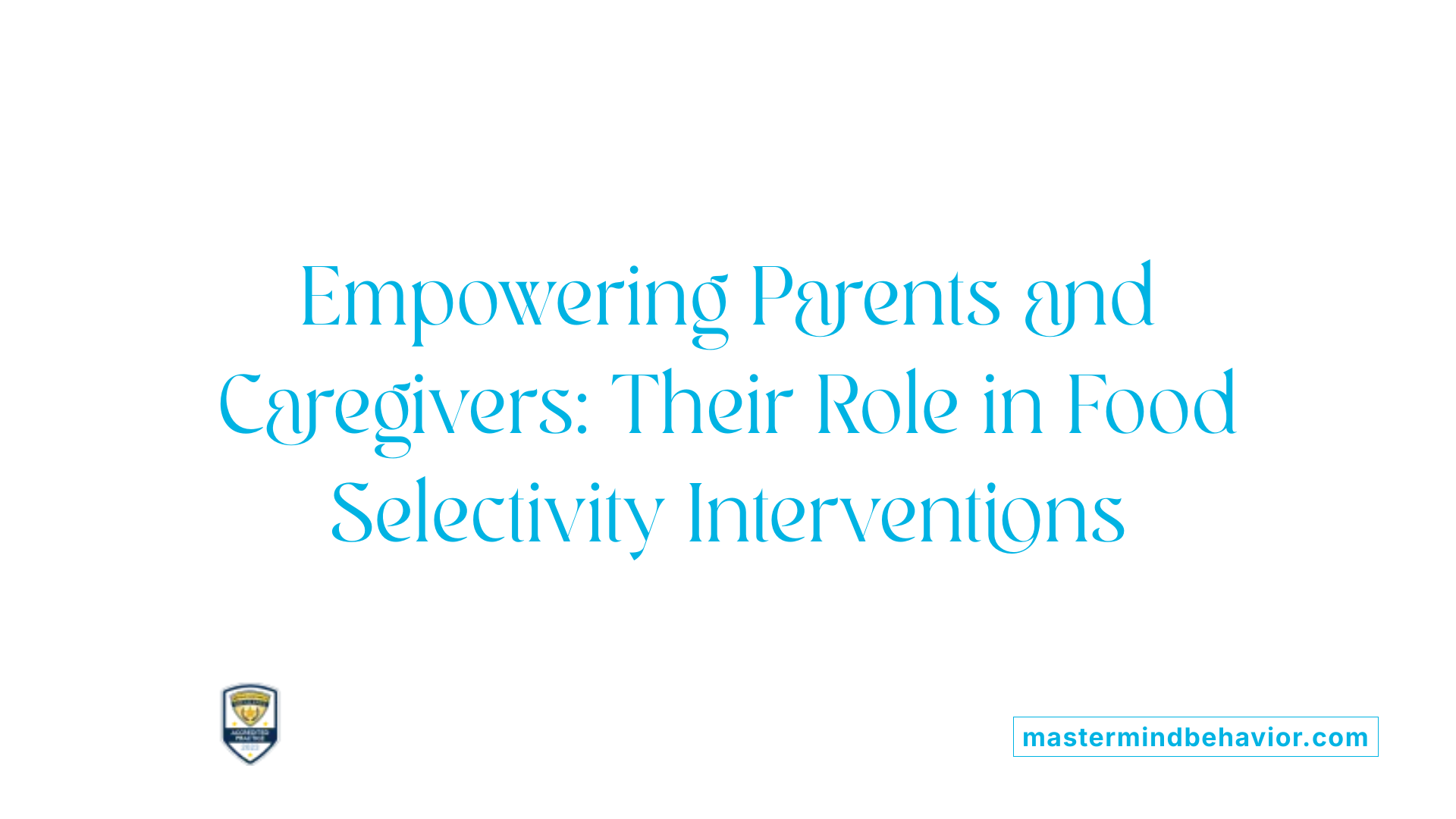
How are training, coaching, and modeling techniques used to support parents and caregivers?
In addressing food selectivity among children with autism, parental involvement is crucial. Evidence-based behavioral strategies often include extensive training and coaching for caregivers. Behavior analysts or clinicians typically demonstrate techniques like modeling, role-playing, and real-time coaching, enabling parents to implement interventions confidently.
Modeling involves showing parents how to present foods, prompt acceptance, and reinforce positive behaviors. During sessions, caregivers observe professionals demonstrating these techniques, which they then practice themselves. This hands-on approach helps embed intervention strategies into daily routines.
Role-playing allows parents to rehearse responses to common mealtime challenges, gaining skill and confidence. Clinicians provide immediate feedback to refine caregiver behaviors, ensuring techniques are applied correctly. Video modeling, an effective form of observational learning, equips parents with clear examples of successful intervention methods that they can emulate at home.
How do these interventions promote the generalization and maintenance of skills?
Consistency across settings is vital for lasting change. Effective parental training ensures that food acceptance behaviors learned during clinical sessions are generalized to home, school, and other environments. When parents are actively involved and utilize similar procedures, children experience fewer disruptions and develop comfort with new foods.
To sustain progress, caregivers are encouraged to develop structured mealtime routines and reinforce behaviors consistently. For example, establishing visual schedules or picture charts at home, similar to those used in therapy sessions, supports routine adherence.
Regular follow-up sessions and booster trainings help maintain the skills over time and troubleshoot any emerging difficulties. Clinicians often promote the use of behavioral charts and data collection tools that children and parents update daily, reinforcing accountability and tracking progress.
What strategies are effective for fostering consistency at home?
Achieving consistency involves several practical strategies. First, caregivers are instructed to use the same reinforcement methods across settings—such as offering favorite toys or activities contingent upon trying a new food. This alignment helps prevent mixed messages that might hinder progress.
Second, establishing predictable mealtime routines reduces anxiety and encourages children to try new foods. Routine consistency might include specific orderings of food presentation, timing of meals, and calming pre-meal activities.
Third, visual supports like picture schedules or social stories can orient children and set clear expectations. These visuals can show the sequence of events or steps involved in trying new foods, making the process less overwhelming.
Fourth, caregiver training emphasizes patience, gradual fading of prompts, and reinforcement schedules, ensuring that children are gradually exposed to new foods without pressure. Reinforcement should be immediate, specific, and motivating.
Finally, involving other caregivers and family members in training ensures a unified approach. When all stakeholders understand and implement consistent strategies, children are more likely to accept a broader diet over time.
Combining these techniques creates a supportive environment that promotes meaningful and enduring improvements in food acceptance, ultimately contributing to better health and quality of life for children with ASD.
Addressing Sensory Processing Anomalies in Food Selectivity
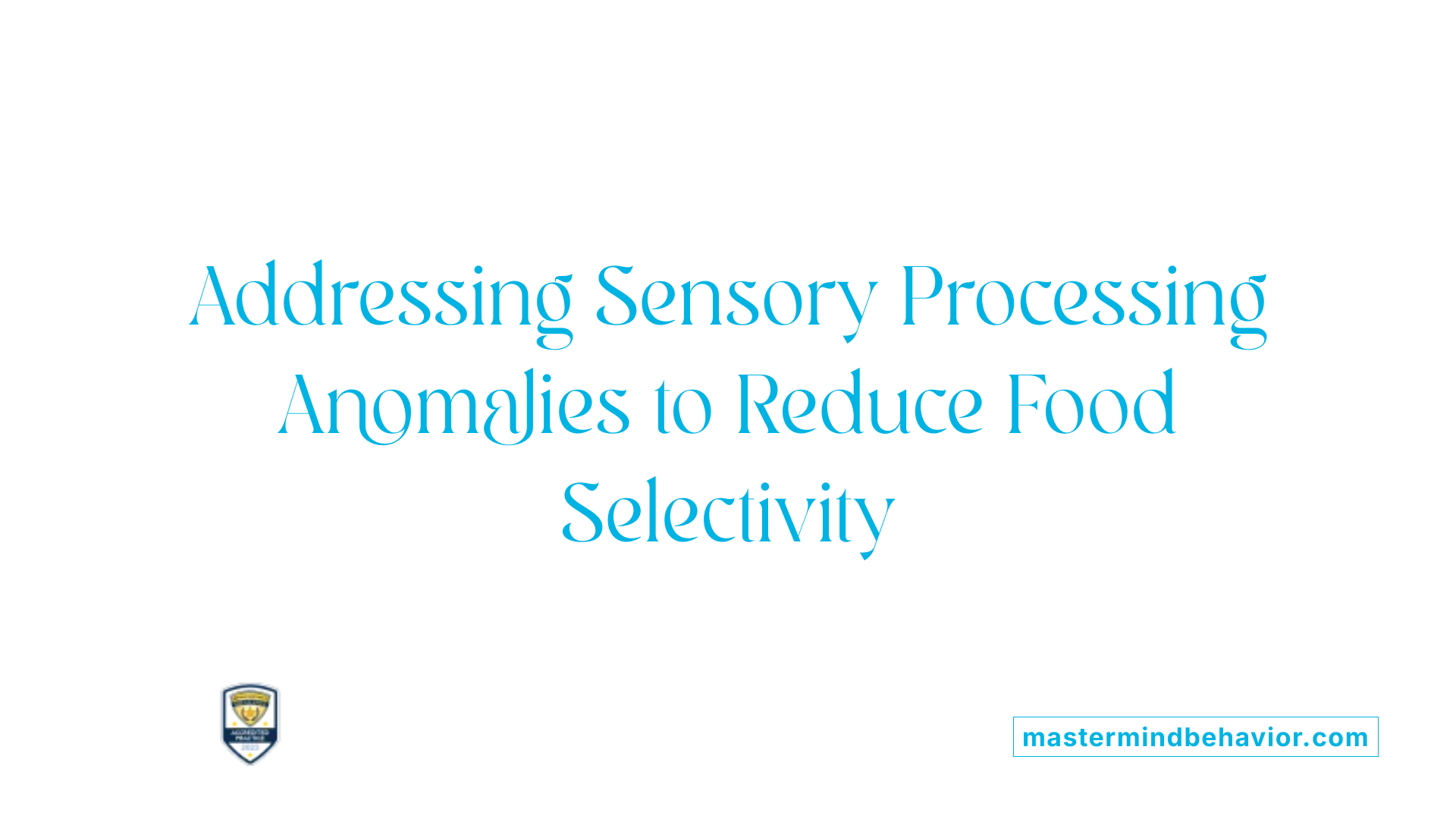
Sensory sensitivities and food preferences
Children with autism spectrum disorder (ASD) frequently experience sensory processing differences, which significantly contribute to food selectivity. These sensory sensitivities can manifest as strong reactions to specific textures, odors, colors, or visual presentation of foods. For many children with ASD, certain textures such as mushy or gritty foods, or strong odors like fish or certain spices, can trigger discomfort or aversion, leading to limited food choices.
This heightened sensory response often results in a restricted diet that excludes entire food groups, potentially causing nutritional deficiencies. Parents often notice their children prefer bland, monotonic, or highly consistent foods, which align with their sensory preferences.
Desensitization to textures, odors, and visual stimuli
Interventions targeting sensory sensitivities aim to gradually decrease aversion through desensitization techniques. This involves a systematic process of exposure where children are slowly introduced to textures, odors, and visual stimuli in a controlled, non-threatening way.
For example, a therapy plan may involve gradually increasing the exposure to different textures, starting with less invasive methods such as touching or smelling the new food before attempting to taste. Often, foods are modified in presentation—such as blending or pureeing—to match the child's current acceptance level, and then gradually progressing towards more defined textures.
Similarly, sensory desensitization might incorporate visual stimuli, such as showing pictures of various foods, before physically introducing the food itself. Odors can be introduced through scented objects or foods in small quantities, increasing exposure over time.
These gradual exposure activities are designed not only to reduce sensory aversions but also to build comfort and acceptance, laying a foundation for accepting a more diverse diet.
Integration with behavioral strategies
Behavioral interventions are crucial in managing food selectivity associated with sensory processing difficulties. Techniques such as preference assessments help identify which sensory inputs are most triggering and which foods are most acceptable for gradual inclusion.
In practice, interventions often combine sensory desensitization with behavioral strategies like differential reinforcement, stimulus fading, and shaping. For example, a child might be rewarded with preferred activities or foods after touching or tasting a new texture, encouraging positive associations.
A common approach includes stimulus fading, where the sensory attributes of a target food are gradually altered—from an initially highly modified form to a more typical presentation—while reinforcing acceptance at each step. Shaping behaviors, such as touching the lips to a new food or taking a small lick, help to incrementally increase acceptance.
Positive reinforcement procedures also motivate children to try unfamiliar textures or odors, with reinforcement scheduled to encourage repeated attempts. These combined strategies aim to reduce anxiety and mealtime distress, fostering a more inclusive and less aversive eating environment.
Current research underscores the importance of personalized sensory-based interventions. Developing an individualized plan that considers each child's unique sensory profile, preferences, and sensitivities enhances the likelihood of success and promotes sustained improvements in dietary variety.
Through consistent application of sensory desensitization integrated with behavioral strategies, children with ASD can overcome sensory-related food selectivity, leading to healthier eating behaviors and better nutritional outcomes.
Long-term Outcomes and Future Directions in ABA Feeding Interventions
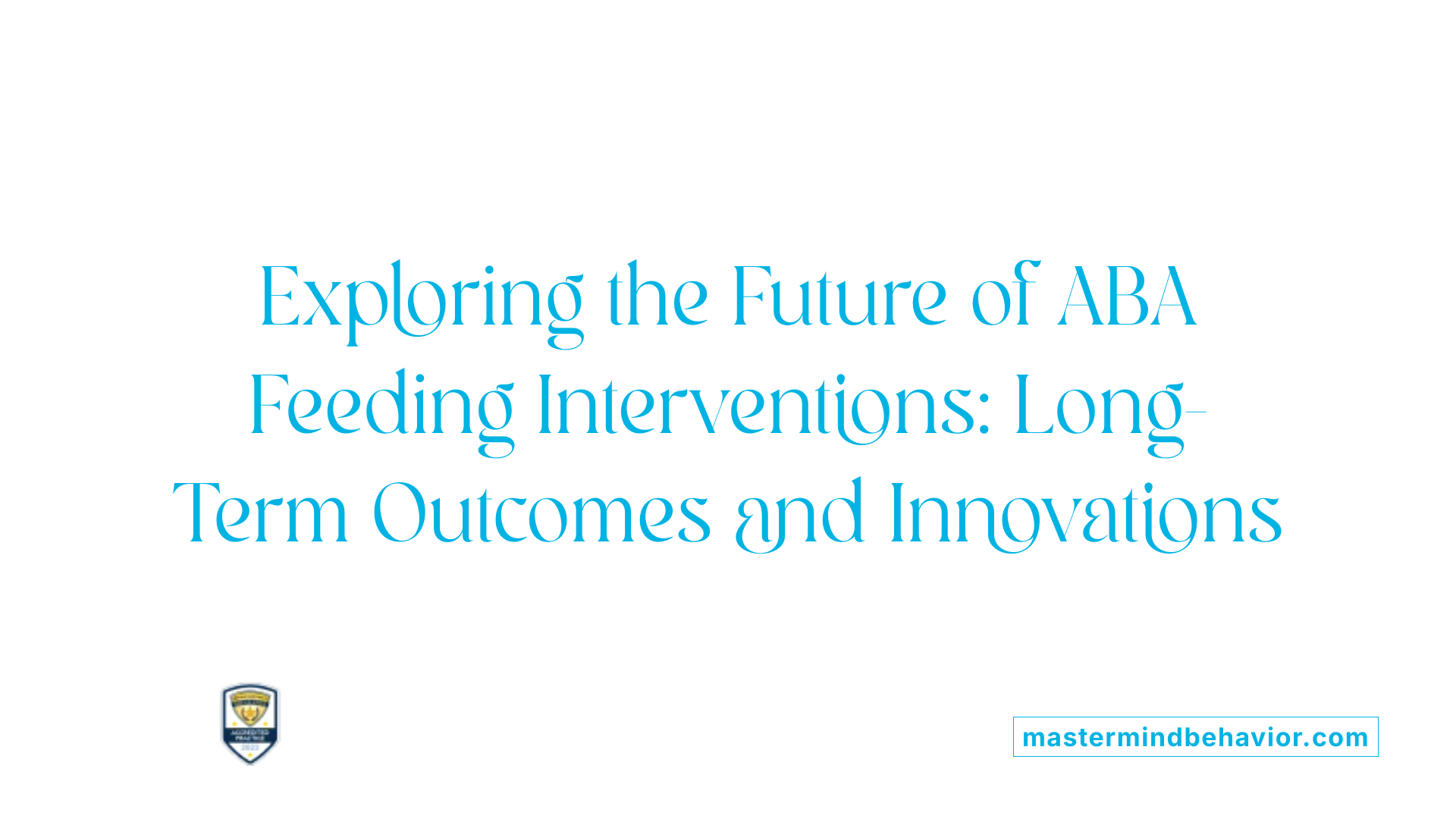
How can behavioral gains be maintained over time?
Sustaining improvements in food acceptance and reducing food selectivity in children with ASD hinges on consistent, ongoing behavioral interventions that are carefully tailored to the child's evolving needs. Establishing structured mealtime routines, using visual supports like picture schedules, and incorporating reinforcement strategies that have proven effective initially can promote long-lasting change. Parents and caregivers play a vital role by continuing to implement these strategies in daily settings, ensuring that the gains achieved through therapy are not lost.
Further, fading routines gradually, so they become less overt but still effective, encourages independence and stability. Regular follow-up assessments by trained professionals help to monitor progress, troubleshoot difficulties, and adjust interventions as needed. Maintenance also involves encouraging generalization—applying learned behaviors across different environments, foods, and people—to prevent relapse.
Research consistently emphasizes the importance of positive reinforcement and parent training to support ongoing success. When families are equipped with the skills to implement and adapt interventions, children are more likely to sustain improved eating behaviors over the long term.
What are current research gaps and emerging strategies?
Despite substantial progress, several gaps remain in understanding how best to promote long-term success in ABA-based feeding interventions. Many studies focus on short-term outcomes, with fewer investigating how to maintain gains over years or during critical developmental transitions.
Emerging strategies aim to address these gaps, including incorporating technology-enhanced interventions, such as apps for tracking progress and providing remote coaching. Additionally, integrating sensory-based approaches with behavioral strategies is gaining attention to tackle sensory processing anomalies more effectively.
Another promising avenue involves utilizing functional analysis to refine individualized plans further; understanding each child's specific triggers and preferences allows for more precise interventions that can produce more durable outcomes.
Researchers are also exploring the ways to improve generalization across settings—home, school, and community—by involving multiple stakeholders and training staff across environmental contexts.
How can interventions be optimized to ensure better generalization and maintenance?
Optimizing interventions for better generalization and longevity involves several approaches. First, interventions should start with a broad assessment that includes sensory profiles, behavioral histories, and medical evaluations, ensuring that the plan is individualized.
Incorporating multiple stimuli, foods, and settings during training helps children adapt their new skills to various environments. For example, introducing foods that differ in texture, taste, and presentation bolsters versatility.
Family involvement is crucial; training parents and caregivers through role-playing, video modeling, and coaching ensures that strategies are consistent across settings. Using visual supports and routine structures increases predictability, which is particularly helpful for children with ASD.
Gradual fading of prompts and supports encourages independence while preventing reliance on external cues. Regular data collection and progress review help to identify when adaptations are needed.
Finally, integrating behavioral interventions with sensory integration techniques, medical management, and nutrition counseling can address the multifaceted nature of food selectivity, improving the likelihood of sustained success.
Promoting Diverse and Healthy Eating Habits
Integrating ABA principles into tailored, systematic interventions can significantly improve food acceptance and mealtime behaviors in children with autism. When combined with medical evaluations, sensory desensitization, and family involvement, ABA-based strategies hold promise for expanding dietary diversity, ensuring nutritional adequacy, and fostering positive mealtime experiences that support long-term health and social integration. Continuous research and collaboration among clinicians, educators, and families are essential to refine these interventions, address future gaps, and promote healthier, more flexible eating habits in children with ASD.
References
- Food Selectivity in Children with Autism: Guidelines for Assessment ...
- Improving Food Selectivity of Children With Autism
- A Treatment Package without Escape Extinction to Address Food ...
- Addressing Feeding Challenges in Children with Autism
- An Overview of Strategies to Address Food Selectivity and Refusal ...
- Sensory Snack Time: A School-Based Intervention Addressing Food ...
- Food Selectivity in Children with ASD - Blog - Achieve Beyond









